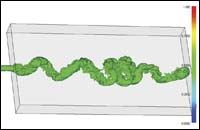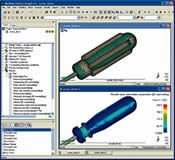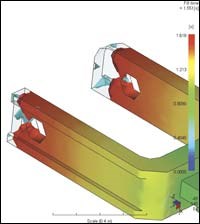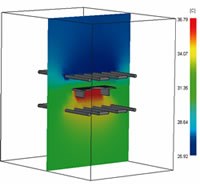Mold Analysis Gets Faster, Easier, Smarter
On Dec. 28, Moldflow Corp. began shipping a major new release of its flagship injection mold simulation software, Moldflow Plastics Insight 6.0.
On Dec. 28, Moldflow Corp. began shipping a major new release of its flagship injection mold simulation software, Moldflow Plastics Insight 6.0. MPI 6.0 is engineered to work much faster, be easier to use, and provide more useful information than before. Many of its enhancements are directed particularly at analyzing thick, solid parts—or thin parts with localized thick sections—using the MPI/3D module, which employs 3D solid-geometry mesh elements. Some of these new features will later be extended to more typical thin-shell plastic geometries that utilize conventional midplane analysis or Moldflow’s proprietary “Dual Domain” surface-mesh technique, supplied in the MPI/Fusion module.
MPI 6.0 also enhances speed and accuracy in analyzing conventional thin-shell parts—for example, in predicting fiber orientation in reinforced parts. There are also improved capabilities for analyzing very thin parts—less 1 mm—which are becoming more common. And the materials database has been expanded with hundreds of new materials and thousands of updates to materials properties.
In recent months, Moldflow also came out with enhancements to its simpler, faster, lower-cost Moldflow Plastics Advisers (MPA), and to other software products for CAD integration.
Faster 3D analysis
Much faster 3D analyses come from a new “coupled 3D flow solver” in MPI 6.0. The older solver offered users a choice of “Fast” or full Navier-Stokes calculations, the latter being slo wer but more accurate. The new coupled 3D flow solver gives only full Navier-Stokes solutions up to 800% faster than before and is even 34% faster than the previous “Fast” analysis.
A number of other 3D flow improvements also result:
- Flow-front advancement can be calculated in larger time steps to gain speed without sacrificing accuracy.
- Shear-heating calculations are said to be more accurate, especially at points where shear changes rapidly along the flow path, such as near a gate and in flows around corners.
- The new 3D Warp solver can calculate warpage of 3D parts an average of 7 times faster. Additional time savings are available from the new ability to use a “coarse-through-thickness” mesh to simplify warp models. This can make calculations up to 35 times faster.
Apart from speed and accuracy improvements, MPI 6.0 provides some previously unavailable information. Moldflow says this is the first software ever to simulate the “jetting” phenomenon when melt first enters a cavity, which tends to be more of a problem in thicker parts. This software advance could be helpful in designing automotive lenses, where jetting of the initial flow through the gate can cause visible defects.
Also new is the ability of MPI/3D to predict partial remelting of the interface zone during overmolding of one plastic with another. This alerts the user to the possibility of smearing the first material into the second. This result is currently available only for 3D analyses.
In addition, MPI/3D now can predict air traps. This feature was previously available for thin-shell models, but 3D analysis can reveal air pockets deep within parts as well as on the surface. MPI/3D can now simulate gas assist much faster through use of 1D beam elements instead of solid elements in runners and overflow wells. (Gas-assist simulation is already available for thin-shell models.)
MPI 6.0 also can aid shop-floor troubleshooting by importing data on actual molding machine characteristics, process settings, and process variations from Moldflow Plastics Xpert (MPX) or Shotscope monitoring systems. This allows a simulation to be run with “real-life” conditions.
- MPI 6.0 can also export hot-runner temperature settings and layouts to Moldflow’s Altanium Matrix process controller, which displays graphic diagrams of the hot-runner system.
- MPI/3D provides new flexibility to display the temperature distribution throughout any cross-section of the mold. This profile of steel temperatures can help optimize cooling-channel layout. (Thin-shell analysis has a more limited capability of this sort.)
- MPI 6.0 can now isolate the causes of warpage for 3D parts as it already does for thin-shell models. It can calculate deflections due to unbalanced cooling, non-uniform shrinkage, and fiber orientation, in addition to the total deflection. In addition, thin-shell simulations have a new ability to isolate warpage due to corner effects.
- Previous ability to calculate core shift has been enhanced with new calculations of stresses on the cores to give insight into core fatigue before actual cracking occurs.
Easier & more flexible
In MPI 6.0 the user interface for all types of analyses has been reorganized for greater convenience and less screen clutter. For example, modeling and meshing tools, which formerly opened in windows on top of the model, now have been moved to panels on the left side of the screen, so as not to obscure the view of the model. Also, the modeling and meshing tools have been consolidated into a graphical Toolbox that avoids the need to pick through menus, and the Project and Study panels are merged into a new Tasks tab. All textual log windows have also been consolidated into one. And now, a single mouse click hides all panels to leave the entire screen free to display the model.
Evaluation of models is faster and easier with a new system of “directed diagnostics.” Diagnostic warnings about meshing problems are now prioritized by degree of severity, and when a problem is selected, the model automatically orients itself to give the best visibility of the problem mesh elements, which are also highlighted.
The system now also automatically identifies isolated, extremely large elements for correction, and the auto-fixing function is extended to correct collapsed areas of the mesh.
Another new ability is local mesh refinement in MPI/3D to increase or decrease the number of layers of elements in a specific area of the model (as already can be done with thin-shell models). Before, 3D analysis allowed users only to increase or decrease the size of elements in the layers.
Now it is also possible to generate analysis reports in Microsoft Word or PowerPoint formats in addition to html.
Faster, simpler, smarter
In September, release 7.2 of Moldflow Plastics Advisers (MPA) added new capabilities to this simplified, easy-to-learn product for preliminary analysis of molding feasibility. One of the main new features is the Advanced Geometry Adviser, which checks a newly constructed model and suggests ways to improve it before starting the analysis. It can identify thick, solid regions that could be thinned to reduce molding cycle time and material cost, thin areas that would retard flow, and cosmetic features such as fillets and text that could be removed from the model because they do not have much effect on analysis results but increase analysis time.
Faster analysis is also possible using a new Naturally Balanced analysis mode. This mode allows you to select a naturally balanced runner system from a library of commonly used layouts. You can then edit the properties of specific runners, if necessary. Analysis is performed on a single highlighted cavity and results are extrapolated to the entire layout. Filling and packing analyses thereby take much less time than a full analysis in standard Multi Cavity mode. In addition, the new release lets you import centerlines of complex or curved runners from a CAD file in IGES format.
The Cooling Circuit Adviser includes a new Cooling System Wizard that helps create cooling circuits more efficiently than before. With the new wizard, you can set channel diameters, distance above and below the parting plane, number of channels, distance between channels, and distance to extend hoses beyond the mold. You can also assign properties to multiple cooling lines at once and specify the cooling inlet location.
MPA 7.2 also reveals not just the location of weld lines and air traps, but the relative seriousness of these defects. It does so by presenting the details on flow-front temperature, pressure drop, injection pressure, and fill time when these defects were formed.
New CAD tools
Two other new updates last September were Moldflow Design Link (MDL) 5.2 and CAD Doctor 2.0. MDL allows direct import of solid geometry data from leading CAD systems into MPI and MPA. MDL 5.2 has updated interfaces to the latest CAD releases of Parasolid, SolidWorks, and Catia.
Moldflow CAD Doctor checks, corrects, and “heals” solid models imported from popular 3D CAD systems in preparation for analyses using MPI and MPA. Version 2.0 has a new interface to MDL to import data from Catia V5, Parasolid, Pro/Engineer, SolidWorks, and STEP formats (vs. just Catia V4 and IGES before).
Related Content
Back to Basics on Mold Venting (Part 1)
Here’s what you need to know to improve the quality of your parts and to protect your molds.
Read MoreDesign Your Tools for Moldability ... and Maintenance
In the initial design phase, when considering the structure and elements of the tool, are you designing them to be maintenance friendly? Canon Virginia has used this approach and preventive maintenance to make tool replacement a thing of the past. You can, too. Here’s how.
Read MoreHow to Design Three-Plate Molds: Part 5
There are many things to consider, and paying attention to the details can help avoid machine downtime and higher maintenance costs. In this installment, the focus is on design and placement of sucker/puller pins.
Read MoreWhere and How to Vent Injection Molds: Part 3
Questioning several “rules of thumb” about venting injection molds.
Read MoreRead Next
Beyond Prototypes: 8 Ways the Plastics Industry Is Using 3D Printing
Plastics processors are finding applications for 3D printing around the plant and across the supply chain. Here are 8 examples to look for at NPE2024.
Read MoreMaking the Circular Economy a Reality
Driven by brand owner demands and new worldwide legislation, the entire supply chain is working toward the shift to circularity, with some evidence the circular economy has already begun.
Read More
























